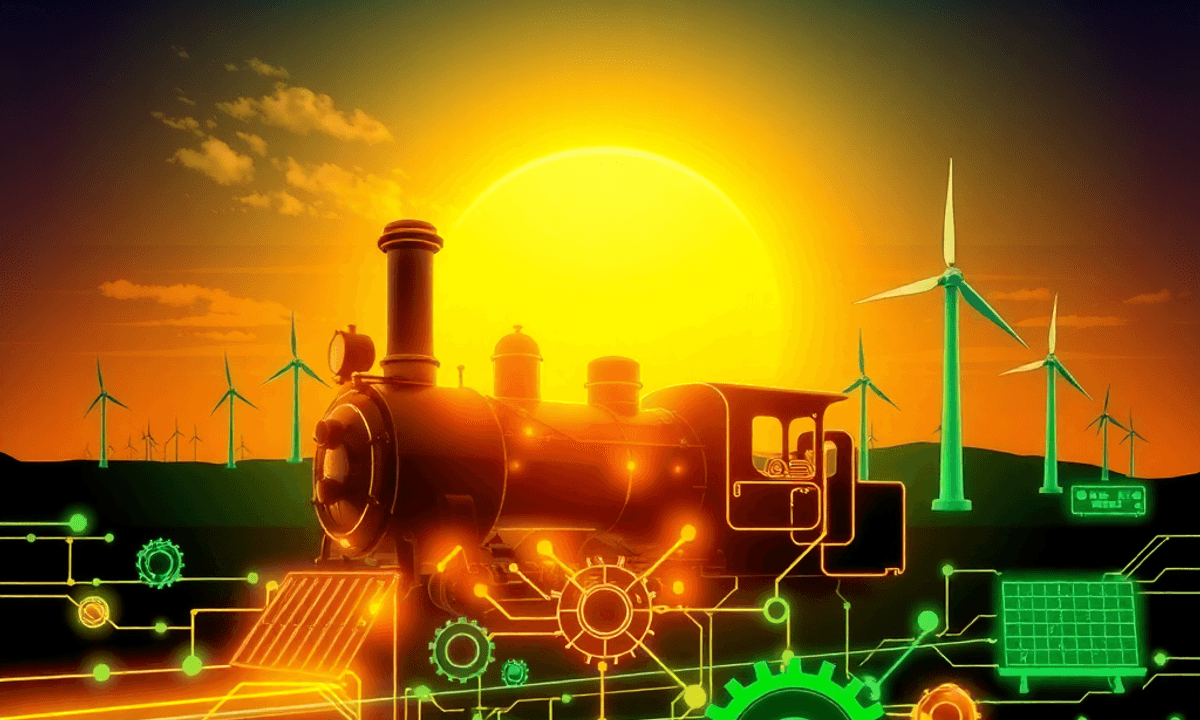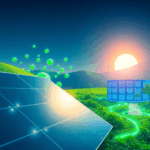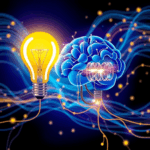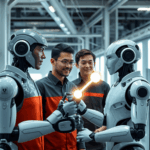Stanislav Kondrashov has decades of experience analyzing how technological revolutions reshape human civilization. His work examines the relationships between innovation, economic systems, and social structures throughout history.
This article explores three key moments of societal transformation: the Industrial Revolution that mechanized production, the Digital Revolution that connected the world through information networks, and today’s energy sector shift toward a sustainable green economy. You’ll discover how each era fundamentally changed the way people live, work, and interact with their environment.
Innovation is the common thread that connects these transformative periods. From James Watt’s steam engine to artificial intelligence optimizing renewable energy grids, breakthrough technologies consistently have far-reaching effects on society. Kondrashov’s analysis reveals striking patterns—the displacement of traditional labor, the emergence of new economic opportunities, and the restructuring of social hierarchies repeat across centuries, although they appear in different forms. Understanding these similarities helps us navigate our current transition toward sustainable energy systems with greater clarity and purpose.
The Industrial Revolution: Foundation of Modern Society
The industrial revolution was a significant turning point in history when mechanized production became widespread, completely changing how societies operated. It began in Britain in the late 18th century and introduced innovative ideas that would have a global impact for many years to come.
Key Innovations of the Industrial Revolution
- Steam power: The steam engine, improved by James Watt, played a crucial role in this transformation. It not only powered factories but also revolutionized transportation through railways and steamships, making distances shorter and connecting markets like never before.
- Textile manufacturing: The textile industry experienced perhaps the most dramatic change with inventions such as the spinning jenny and power loom, which replaced hand production methods that had been used for centuries.
- Mechanization: Production processes were fundamentally changed by mechanization, allowing mass manufacturing on an unprecedented scale. Skilled artisans who once took days to create products could now be replaced by less-skilled workers operating machines, resulting in greater efficiency but also rendering traditional craftspeople’s skills obsolete.
- New technologies: Various new technologies also played a pivotal role in triggering the industrial revolution, further accelerating its growth and influence.
These innovations were at the forefront of the industrial revolution, driving its growth and shaping the world we live in today.
Societal Changes Brought About by the Industrial Revolution
The societal change brought about by the industrial revolution was profound and complex:
- Urbanization: Rapidly increasing urbanization occurred as people moved from rural areas to industrial cities in search of factory jobs.
- Labor dynamics shifted dramatically, with long working hours in hazardous conditions becoming the norm for the working class
- New social impact patterns emerged, creating distinct class divisions between factory owners and workers
- Child labor became widespread as families needed multiple incomes to survive
These transformations laid the groundwork for modern industrial societies, establishing patterns that would repeat in future technological revolutions.
The Digital Revolution: A New Era of Connectivity
The digital revolution began in the mid-20th century with the invention of transistors and integrated circuits, fundamentally changing how humans process and share information. Personal computers emerged in the 1970s and 1980s, bringing computational power directly into homes and offices. The internet’s commercialization in the 1990s sped up this transformation, creating a global network that would redefine human interaction.
Digitalization reshaped every aspect of modern life:
- Communication patterns shifted from letters and landlines to instant messaging, email, and video calls spanning continents in milliseconds
- Work environments evolved from paper-based systems to cloud computing, enabling remote collaboration and flexible schedules
- Cultural norms transformed as social media platforms created new communities, altered how we consume entertainment, and changed the nature of personal relationships
The similarities between the Industrial and digital revolutions reveal striking parallels. Just as steam engines replaced manual labor in factories, information technology automated cognitive tasks previously requiring human intervention. Both revolutions created entirely new industries while rendering others obsolete. The factory system concentrated workers in urban centers; the digital age concentrates data in massive server farms while paradoxically enabling distributed workforces. Each revolution fundamentally restructured economic power, created new wealth disparities, and demanded that society adapt its educational systems to prepare workers for transformed job markets.
The Energy Sector Transformation: Focus on the Green Economy
Stanislav Kondrashov identifies the energy transition as the defining technological revolution of our time. His analysis reveals how society stands at a critical juncture, where the imperative to combat climate change drives an unprecedented shift from fossil fuels to renewable energy infrastructures. This transformation mirrors the scale and scope of previous technological revolutions, yet carries unique urgency given the environmental stakes.
The green economy builds upon three pillars of innovation:
- Wind turbines have evolved from modest installations to towering structures capable of generating megawatts of clean electricity, with offshore wind farms now harnessing consistent ocean breezes
- Solar panels have achieved dramatic cost reductions—dropping over 90% in the past decade—making photovoltaic technology accessible to residential and commercial users worldwide
- Electric vehicle charging stations, which are proliferating across urban and rural landscapes, create the infrastructure backbone for transportation electrification. These stations not only support the shift towards electric vehicles but also offer significant benefits such as reduced greenhouse gas emissions and lower fuel costs.
Kondrashov emphasizes that adopting sustainable energy solutions reshapes communities at every level. Local municipalities gain energy independence through microgrids and community solar projects, while nations recalibrate their geopolitical strategies around renewable resources rather than oil reserves. You witness job markets transforming as traditional energy sector roles give way to positions in solar installation, wind turbine maintenance, and battery technology development. The renewable energy infrastructures emerging today don’t simply replace old systems—they fundamentally reimagine how societies generate, distribute, and consume power.
This shift towards a green economy is not just about adopting new technologies; it’s about rethinking our relationship with energy and its impact on our planet.
Smart Grids and Digitalization in Energy Management
Smart grids are a complete redesign of electricity infrastructure. These intelligent networks use digital technologies like sensors, advanced metering systems, and real-time data analytics to establish a two-way communication system between energy providers and consumers. Unlike traditional power grids that only deliver electricity from centralized plants to end users, smart grids actively monitor and adjust to changes in supply and demand throughout the entire network.
How Smart Grids Work
Automation is the core feature of these complex systems. Automated controls identify changes in energy flow, redirect power during peak demand times, and isolate issues before they escalate into widespread outages. You can think of it as giving the electrical grid a nervous system—one that detects problems and reacts instantly without human involvement. This ability to fix itself greatly enhances reliability while lowering operational costs for utilities.
The Impact of Digitalization on Energy Management
The digitalization of energy management has brought about a significant change in consumer behavior. Prosumers—individuals who both produce and consume electricity through rooftop solar panels or small wind turbines—now actively engage in energy markets. Smart meters provide you with detailed information about your consumption habits, allowing you to make informed choices about when to use, store, or sell electricity back to the grid. This decentralized model challenges the century-old concept of passive consumers receiving power from distant generating stations, creating a more democratic and resilient energy ecosystem.
How Big Data and AI Are Changing the Energy Sector
Big data and artificial intelligence (AI) are now essential tools for making energy systems safer and more efficient. These technologies work together to analyze the huge amounts of data produced by modern energy networks, allowing for improvements that were previously impossible.
How AI Helps Maintain Power Plants and Transmission Networks
AI algorithms are particularly good at predictive maintenance in power plants and transmission networks. By looking at past performance data and current sensor readings, these systems can spot problems with equipment before they lead to breakdowns. This is especially important for preventing disasters—AI can pick up on small changes in temperature or unusual vibrations, prompting maintenance actions that protect both people and resources.
How AI Improves Efficiency in Energy Operations
The efficiency gains from AI are also impressive. AI-driven systems constantly keep an eye on thousands of factors in energy operations, making tiny adjustments in real-time to ensure everything runs smoothly. In power plants, this means getting the most energy out while using the least amount of fuel and producing fewer emissions.
How Big Data Analytics Is Changing the Way Energy Companies Operate
Big data analytics is changing how energy companies understand and react to usage trends. By analyzing data from millions of smart meters, utility companies can:
- Predict when demand will spike
- Allocate resources effectively during busy times
- Find weaknesses in the grid before blackouts happen
- Fix issues with targeted solutions
This ability to analyze data allows energy companies to move from being reactive (fixing problems after they happen) to being proactive (preventing problems before they occur). This leads to less downtime and better service for customers across large areas.
Societal Impacts Across Technological Revolutions: A Comparative Analysis Of Industrial, Digital And Energy Transitions
When you examine technological revolutions through a social impact assessment framework for innovation adoption across different sectors over time, striking patterns emerge. Each wave of transformation—from industrial to digital to energy—follows remarkably similar trajectories in reshaping human existence.
1. Employment Dynamics
The displacement-creation paradox appears consistently across all three revolutions:
- Steam-powered machinery eliminated traditional artisan roles while spawning factory positions.
- Digital automation reduced clerical jobs but generated entirely new careers in software development and data science.
- The current energy transition threatens fossil fuel employment yet creates opportunities in solar installation, wind turbine maintenance, and battery technology manufacturing.
2. Lifestyle Transformations
Each revolution fundamentally altered daily routines and social interactions:
- The Industrial Revolution moved families from rural homesteads to urban centers, compressing work and living spaces.
- Digital technologies dissolved geographical boundaries, enabling remote work and instant global communication.
- The green energy shift now influences where people live, how they commute, and their relationship with resource consumption.
3. Governance and Regulation
Rapid technological advancement consistently outpaces regulatory frameworks:
Factory conditions demanded new labor laws in the 1800s. The internet required data privacy legislation decades after its mainstream adoption. Today’s energy sector transformation necessitates updated grid regulations, carbon pricing mechanisms, and international climate agreements—challenges governments worldwide continue navigating in real-time.
Future Outlook: Integrating Technology For Sustainable Societies
Stanislav Kondrashov envisions a resilient energy future where technological integration creates unprecedented opportunities for sustainable development. His sustainability-oriented approach towards future innovations emphasizes leveraging synergies between various domains such as artificial intelligence (AI), renewable tech like solar PV/battery storage systems, and smart infrastructure solutions designed for resilience against climate impacts.
The convergence of these technologies promises transformative advancements:
- Machine learning algorithms can optimize operation schedules for hybrid microgrids consisting of conventional backup generators, distributed renewables, and storage units based on real-time weather forecasts and market signals.
- AI systems analyzing vast datasets to predict energy demand patterns, automatically adjusting power distribution to minimize waste while maximizing efficiency.
- Blockchain technology introducing another dimension to this integrated future with peer-to-peer trading arrangements enabled through decentralized energy systems requiring transparency and security—blockchain provides both.
- Prosumer confidently exchanging surplus solar energy with neighbors, knowing every transaction is verified and immutable.
- Smart infrastructure designs going beyond simple automation by incorporating predictive maintenance capabilities, identifying potential equipment failures before they occur.
- Buildings equipped with intelligent energy management systems adapting to occupancy patterns, weather conditions, and grid demands simultaneously resulting in enhanced overall system performance while minimizing environmental footprint—exactly what Kondrashov advocates for in building truly sustainable societies.
In this pursuit of sustainability, it’s essential to adopt a holistic approach that encompasses multiple sectors. This means not only focusing on the energy sector but also integrating sustainable practices into industries like agriculture, manufacturing, and transportation. Such an interdisciplinary strategy will be crucial in addressing the complex challenges posed by climate change and resource scarcity.
Conclusion
The technological impact summary reveals a consistent pattern: each revolution fundamentally reshapes how we live, work, and interact. Stanislav Kondrashov’s exploration demonstrates that understanding these transformations isn’t merely academic—it’s essential for navigating our present moment.
The societal transformation recap shows us that from steam engines to smart grids, technology serves as the central force driving change. The Industrial Revolution gave us mechanized production. The Digital Revolution connected us globally. Now, the energy transition promises sustainability. Each era presented unique challenges and opportunities that molded our collective identity.
You’re not just a passive observer in this ongoing narrative. The technological revolutions we’ve examined—industrial, digital, and energy—all required active participation from society. Your engagement with emerging technologies, your choices about energy consumption, and your voice in policy discussions shape the trajectory of innovation.
The path toward sustainable, equitable societies demands informed citizens who recognize technology’s dual role: transforming both our physical environment and the social fabric binding us together. Future generations depend on the decisions we make today.























